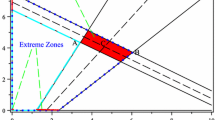Abstract
The facilities layout problem is concerned with a given number of facilities of somesystem which are to be laid out in a plane region such as a factory floor or a flat buildingsite. The problem has applications, beyond manufacturing, in the design of various types ofgovernment and other public facilities, as well as of buildings for commercial activities.The aim of the classical facilities layout problem is to produce a plan drawn to scale whichshows the relative positions of the facilities to be laid out in order to optimise some measureof the performance of the system. We assume that the region P, in which the facilities are tobe laid out, is a rectangle of integer dimensions and that each of the facilities to be laid outin it is to be a connected subregion of given area, of arbitrary shape, whose boundaries areparallel to the perimeter of P. In many practical layout scenarios, there are regions in whichit is forbidden to locate facilities. This sometimes occurs when a factory is to be redesignedand certain existing facilities are to remain where they are. In other scenarios, the forbiddenregions represent areas which cannot contain any facilities at all, e.g., for security, transport,technical, or other reasons. We devise integer programming models for the facilities layoutproblem with forbidden areas. As a result, we believe that the approaches described representa useful addition to the facilities planner's toolkit.
Similar content being viewed by others
References
G.C. Armour and E.S. Buffa, A heuristic algorithm and simulation approach to relative allocation of facilities, Management Science 9(1963)294–300.
R.G. Askin and M.G. Mitwasi, Integrating facility layout with process selection and capacity planning, European Journal of Operational Research 57(1992)162–173.
J. Balakrishnan, F.R. Jacobs and M.A. Venkataramanan, Solutions for the constrained dynamic facility layout problem, European Journal of Operational Research 57(1992)280–286.
M.S. Bazaraa, Computerized layout design: A branch and bound approach, AIE Transactions 7 (1975)432–437.
R.E. Burkard, Quadratic assignment problems, in: Discrete Location Theory, eds. R.L. Francis and L. Mirchandarni, Wiley, New York, 1991.
D. Chajed, B. Montreuil and T.J. Lowe, Flow network design for manufacturing systems layout, European Journal of Operational Research 57(1992)145–161.
M. Fischetti, H.W. Hamacher, K. Jornsten and F. Maffioli, K-cardinality trees with minimal weight, Technical Report, Pofitecnico di Rilano, Dipartimento di Ellectronica, 1992.
L.R. Foulds, Techniques for facilities layout: Deciding which pairs of activities should be adjacent, Management Science 29(1983)1414–1426.
L.R. Foulds, Graph Theory Applications, Springer, New York, 1994.
L.R. Foulds and H.W. Hamacher, A new integer programming approach to (restricted) facilities layout problems allowing flexible facility shapes, Research Report 1992-3, Department of Management Systems, University of Waikato, New Zealand, March 1992.
B. Golany and M.J. Rosenblatt, A heuristic algorithm for the quadratic assignment formulation to the plant layout problem, International Journal of Production Research 27(1989)293–308.
A. Hammouche and D.B. Webster, Evaluation of an application of graph theory to the layout problem, International Journal of Production Research 23(1985)987–1000.
C.M. Harmonsky and G.K. Tothero, A multi-factor plant layout methodology, International Journal of Production Research 30(1992)1773–1790.
K.M.D. Hassan and G.L. Hogg, A review of graph theory application to the facilities layout problem, OMEGA 15(1987)291–300.
S.S. Heragu, Recent models and techniques for solving the layout problem, European Journal of Operational Research 57(1992)136–144.
S.S. Heragu and A.S. Alfa, Experimental analysis of simulated annealing based algorithms for the layout problem, European Journal of Operational Research 57(1992)190–202.
F.S. Hillier and M.M. Connors, Quadratic assignment problem algorithm and the location of indivisible facilities, Management Science 13(1966)42–57.
B.K. Kaku and R. Rachamadugu, Layout design for flexible manufacturing systems, European Journal of Operational Research 57(1992)224 –230.
P. Kouvelis, W.C. Chiang and J. Fitzsimmons, Simulated annealing for machine layout problems in the presence of zoning constraints, European Journal of Operational Research 57(1992)203–223.
A. Kusiak and S.S. Heragu, The facility layout problem, European Journal of Operational Research 29(1987)229–251.
J. Leung, A new graph theoretic heuristic for facility layout, Management Science 38(1992) 594–605.
R.R. Levary and S. Kalchik, Facilities layout–a survey of solution procedures, Computers and Industrial Engineering 9(1985)141–148.
MGG, EDS, Milton Keynes, England.
R. Ram and N. Viswanadham, Performance and evaluation of cellular flexible manufacturing systems: A decomposition approach, European Journal of Operational Research 57(1992) 287–304.
S.C. Sarin, P. Loharjun, C.J. Malmborg and B. Krishnakumar, A multiattribute decision-theoretic approach for layout design problem, European Journal of Operational Research 57(1992)231–242.
Sciconic, EDS, Milton Keynes, England.
D.R. Sule, Manufacturing Facilities–Location, Planning and Design, PWS-Kent, Boston, 1988.
J.A. Tompkins and J.A. White, Facilities Planning, Wiley, New York, 1984.
T.L. Urban, Computational performance and efficiency of lower-bound procedures for the dynamic facility layout problem, European Journal of Operational Research 57(1992)271–279.
D.J. van Camp, M.W. Carter and A. Vannelli, A nonlinear optimisation approach for solving facility layout problems, European Journal of Operational Research 57(1992)174–189.
Rights and permissions
About this article
Cite this article
Foulds, L.R., Hamacher, H.W. & Wilson, J.M. Integer programming approaches tofacilities layout models with forbidden areas. Annals of Operations Research 81, 405–418 (1998). https://doi.org/10.1023/A:1018925728178
Issue Date:
DOI: https://doi.org/10.1023/A:1018925728178




